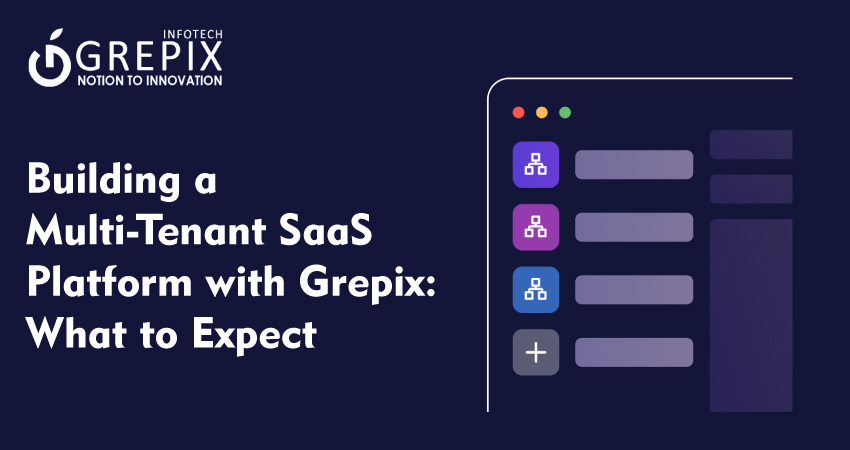Building a Multi-Tenant SaaS Platform with Grepix: What to Expect
The SaaS industry is exploding projected to reach $908.21 billion by 2030 (Grand View Research). But as demand grows, so do user expectations for security, scalability, and customization.
If you’re building a multi-tenant SaaS platform, you’re likely facing questions like:
- How do I isolate tenant data without sacrificing performance?
- Which SaaS scalability strategies are future-proof?
- How do I balance cost efficiency with compliance requirements?
At Grepix, we’ve helped businesses across industries design and deploy multi-tenant SaaS architectures that meet enterprise-grade requirements from day one.
This guide will walk you through what to expect when building your SaaS with us from tenant isolation techniques to real-life deployment strategies.
Building a multi-tenant SaaS platform requires a strategic approach to architecture, scalability, and compliance. With a single application instance serving multiple customers, tenant isolation, secure data partitioning, and efficient resource allocation become critical. This guide explores the fundamentals of multi-tenant SaaS architecture, comparing shared vs dedicated database models, and detailing best practices for IAM, monitoring, and metering. It also covers common multi-tenant SaaS challenges, including compliance with regulations like GDPR and HIPAA. Grepix’s development process from discovery to deployment ensures scalability, security, and cost efficiency, tailored to each client’s needs. Real-world examples highlight how Grepix reduces infrastructure costs, speeds onboarding, and maintains near-perfect uptime. Whether starting fresh or migrating from a single-tenant model, the right SaaS scalability strategies can future-proof your platform. Partnering with Grepix guarantees a secure, high-performance SaaS solution designed to grow with your business.
Understanding Multi-Tenant SaaS Architecture
What is Multi-Tenancy?
Multi-tenancy is a software architecture where a single application instance serves multiple customers (tenants). Each tenant’s data and configurations are logically isolated but physically integrated, enabling resource sharing without compromising privacy.
Key Benefits:
- Lower infrastructure costs
- Simplified maintenance & updates
- Faster onboarding for new clients
Shared vs Dedicated Database Models in SaaS
- Shared Database: All tenants share one database, with data partitioned logically.
- Pros: Cost-effective, easy to scale horizontally.
- Cons: Requires strict partitioning rules to avoid data leaks.
- Dedicated Database: Each tenant has its own database.
- Pros: Strong isolation, easier compliance.
- Cons: Higher hosting costs, complex updates.
Grepix Insight: We recommend a hybrid model for many enterprise clients combining shared DBs for small tenants and dedicated DBs for larger, compliance-sensitive ones.
Core Challenges in Multi-Tenant SaaS Development
Building multi-tenant SaaS applications comes with unique hurdles.
1 Tenant Isolation Techniques
Isolation ensures no tenant can access another’s data. Techniques include:
- Row-Level Security (RLS) in databases
- Separate schemas per tenant
- Encryption at rest & in transit
- VPC isolation in cloud environments
2 SaaS Data Partitioning Strategies
Data partitioning impacts performance and compliance. Grepix often evaluates:
- Horizontal partitioning (per-tenant tables or schemas)
- Vertical partitioning (splitting sensitive data into separate storage)
3 Identity and Access Management (IAM) in Multi-Tenant SaaS
Robust IAM ensures only authorized users can access tenant resources.
- Role-based access control (RBAC)
- Single Sign-On (SSO) with OAuth or SAML
- Multi-Factor Authentication (MFA)
4 Multi-Tenant Compliance Considerations
SaaS platforms often need to comply with GDPR, HIPAA, or SOC 2.
- Data residency controls
- Audit logging & retention policies
- Consent management tools
SaaS Scalability Strategies for Multi-Tenant Platforms
Scalability is the lifeline of SaaS growth.
Horizontal Scaling
Add more application instances to handle load. Cloud providers like AWS, Azure, and GCP make this easy with auto-scaling groups.
Vertical Scaling
Boost resources (CPU, RAM) of existing servers suitable for initial stages but less cost-efficient at scale.
Database Sharding
Split data across multiple servers to balance queries and improve performance.
Building Multi-Tenant SaaS Applications with Grepix Step by Step
Here’s what you can expect in a Grepix-led SaaS development process:
1 Discovery & Requirement Analysis
We start with:
- Business use case mapping
- Compliance needs assessment
- User volume & data growth projections
2 Architecture Design
We design your multi-tenant SaaS architecture with:
- Database model selection (shared, dedicated, or hybrid)
- Tenant isolation methods
- Monitoring & metering setup
3 Development & Integration
Our engineers build:
- Core SaaS modules (user management, billing, analytics)
- Tenant-aware APIs
- Security layers including IAM and encryption
4 Multi-Tenant Monitoring and Metering
We set up:
- Resource usage tracking per tenant
- Custom billing triggers
- Performance alerts for proactive scaling
5 Testing & Quality Assurance
We conduct:
- Load testing with simulated tenant traffic
- Security penetration tests
- Compliance audits
6Deployment & Go-Live
Using CI/CD pipelines, we ensure zero-downtime deployments.
7 Post-Launch Support & Scaling
Grepix offers:
- 24/7 support
- Continuous optimization
- Feature rollouts without tenant disruption
Real-World Example Grepix Case Study
Client: Global HR SaaS provider
Challenge: Needed to serve 5,000+ companies across 3 continents with varying compliance needs.
Solution:
- Hybrid DB model
- Role-based IAM with SSO integration
- Automated scaling on AWS
Result:
- Reduced infrastructure cost by 40%
- Onboarded new tenants in < 2 hours
- Achieved 99.99% uptime
Conclusion
Building a multi-tenant SaaS platform is no longer optional for companies aiming to scale globally it’s the standard. With the right SaaS scalability strategies, tenant isolation techniques, and data partitioning models, you can create a platform that balances cost, performance, and compliance.
At Grepix, we bring years of experience in SaaS platform development, helping businesses design and launch solutions that grow with their customers. Whether you’re starting fresh or migrating from a single-tenant setup, our approach ensures your SaaS is secure, scalable, and future-ready.
🚀 Ready to build your multi-tenant SaaS? Contact Grepix today.
FAQs
1. What’s the difference between shared and dedicated databases in multi-tenant SaaS?
Shared databases are cost-efficient but require strict partitioning, while dedicated databases provide stronger isolation at a higher cost.
2. How can I handle compliance in a multi-tenant SaaS platform?
Use audit logging, encryption, and ensure data residency rules are met for regions like EU (GDPR).
3. What is IAM in multi-tenant SaaS?
Identity and Access Management controls who can access what, ensuring secure and compliant usage.
4. How do you meter usage in multi-tenant SaaS?
Track compute, storage, and API calls per tenant, and feed data into your billing system.
5. Can I scale multi-tenant SaaS without downtime?
Yes, with horizontal scaling, load balancing, and CI/CD pipelines.
Launch your vision with our mobile app development company, where innovation meets excellence to create cutting edge mobile solutions."







